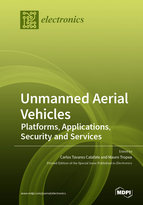Unmanned Aerial Vehicles: Platforms, Applications, Security and Services
A special issue of Electronics (ISSN 2079-9292). This special issue belongs to the section "Networks".
Deadline for manuscript submissions: closed (31 May 2020) | Viewed by 36273
Special Issue Editors
Interests: UAV networking and communications solutions; drone swarms; UAS traffic management (UTM); IoT; Traffic management
Special Issues, Collections and Topics in MDPI journals
Interests: satellite networks; vehicular ad-hoc networks (VANET); flying ad-hoc networks (FANET); UAVs; channel modeling
Special Issues, Collections and Topics in MDPI journals
Special Issue Information
Dear Colleagues,
The use of unmanned aerial vehicles (UAVs) has attracted prominent attention from researchers, engineers, and investors in multidisciplinary fields such as agriculture domain, coverage issues, emergency situations, disaster events, farmland and environment monitoring, 3D-mapping, etc. The use of this technology is playing an important role in supporting human activities. Man is concentrating more and more on intellectual work, trying to make practical activities more and more automated in order to increase their efficiency. In this regard, the use of drones is increasingly becoming a key aspect of this automation process. A drone offers many advantages including agility, efficiency, and reduced risk, especially in dangerous missions.
The research on UAVs is becoming increasingly important and, for this reason, we want to propose a Special Issue where we invite submissions of technical papers that may address, but are not limited to, the following topics:
- UAV platforms: system aspects, sensors, and actuators equipment, architecture/integration, experimental results with prototypes, field tests, test-beds, deployment results, communication system, UAV coordination, algorithms and protocols studies, etc.
- UAV power/energy efficiency: renewable energy on-board, energy harvesting, wireless power transmission, batteries, smart energy management, etc.
- Connectivity issues: software-defined radio/networks, virtualized networks, heterogeneous networks, routing protocols, coverage aspects, footprint, channel modeling, etc.
- Real-time services and applications: localization, unmanned aerial vehicles for autonomous vehicles, QoS services, connection guarantees, real-time communications, video streaming, voice over IP, call conferences, network gaming, slow delay applications, etc.
- Security and privacy for UAVs: identification, authentication, cryptography, network security, aerial surveillance, UAVs for civil security, UAVs cyber security, etc.
Prof. Dr. Carlos Tavares Calafate
Dr. Mauro Tropea
Guest Editors
Manuscript Submission Information
Manuscripts should be submitted online at www.mdpi.com by registering and logging in to this website. Once you are registered, click here to go to the submission form. Manuscripts can be submitted until the deadline. All submissions that pass pre-check are peer-reviewed. Accepted papers will be published continuously in the journal (as soon as accepted) and will be listed together on the special issue website. Research articles, review articles as well as short communications are invited. For planned papers, a title and short abstract (about 100 words) can be sent to the Editorial Office for announcement on this website.
Submitted manuscripts should not have been published previously, nor be under consideration for publication elsewhere (except conference proceedings papers). All manuscripts are thoroughly refereed through a single-blind peer-review process. A guide for authors and other relevant information for submission of manuscripts is available on the Instructions for Authors page. Electronics is an international peer-reviewed open access semimonthly journal published by MDPI.
Please visit the Instructions for Authors page before submitting a manuscript. The Article Processing Charge (APC) for publication in this open access journal is 2400 CHF (Swiss Francs). Submitted papers should be well formatted and use good English. Authors may use MDPI's English editing service prior to publication or during author revisions.
Keywords
- UAVs platforms
- UAV power/energy efficiency
- Connectivity Issues
- Real-time services and applications
- Security and privacy for UAVs







